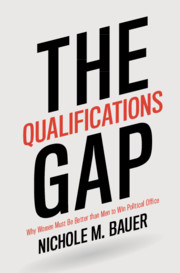Book contents
- The Qualifications Gap
- The Qualifications Gap
- Copyright page
- Dedication
- Contents
- Figures
- Tables
- Acknowledgments
- 1 The Gendered Qualification Gap
- 2 Fomenting a Gender Rebellion
- 3 No Place for Women
- 4 A Gendered Information Gap
- 5 Do Voters Expect Women to Be Better than Men?
- 6 Different Parties, Different Standards
- 7 Gender Bias, Disrupted
- 8 The Future Is Female
- Appendixes
- References
- Index
6 - Different Parties, Different Standards
Published online by Cambridge University Press: 17 July 2020
- The Qualifications Gap
- The Qualifications Gap
- Copyright page
- Dedication
- Contents
- Figures
- Tables
- Acknowledgments
- 1 The Gendered Qualification Gap
- 2 Fomenting a Gender Rebellion
- 3 No Place for Women
- 4 A Gendered Information Gap
- 5 Do Voters Expect Women to Be Better than Men?
- 6 Different Parties, Different Standards
- 7 Gender Bias, Disrupted
- 8 The Future Is Female
- Appendixes
- References
- Index
Summary
Stereotypes about women and men influence how voters evaluate the qualifications of political candidates, but stereotypes about gender sharply intersect with stereotypes about political parties. Chapter 6 builds on Chapter 5 and investigates how stereotypes about Democrats and Republicans affects evaluations of Democratic and Republican female candidates. Voters stereotype Democrats as feminine and Republicans as masculine. These stereotypes, I contend, create a set of gendered partisan-typicality standards that affect how voters select candidates in primary elections. Republican female candidates face obstacles in primary elections where Republican voters are more likely to support a Republican male relative to a Republican female candidate. Partisan-typicality standards shaped by gender stereotypes contribute to the partisan gender gap in political representation.
- Type
- Chapter
- Information
- The Qualifications GapWhy Women Must Be Better than Men to Win Political Office, pp. 118 - 141Publisher: Cambridge University PressPrint publication year: 2020
- 1
- Cited by

